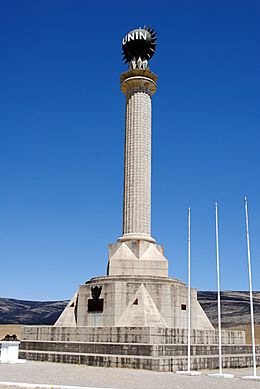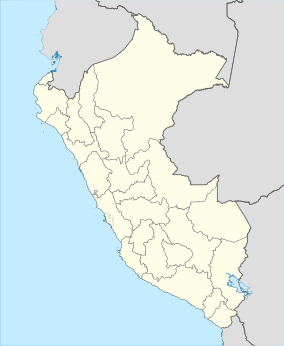Chacamarca Historic Sanctuary facts for kids
Quick facts for kids Chacamarca Historic Sanctuary |
|
|---|---|
| Santuario Histórico de Chacamarca | |

Obelisk at Chacamarca Historic Sanctuary
|
|
| Location | Junín Region |
| Nearest city | Junín |
| Area | 25 km2 (9.65 sq mi) |
| Established | 7 August 1974 |
| Governing body | SERNANP |
| Website | Santuario Histórico de Chacamarca |
The Chacamarca Historic Sanctuary (in Spanish: Santuario Histórico de Chacamarca) is a special place in Junín Province, Junín, Peru. This sanctuary protects the area where an important battle happened. It also keeps safe old ruins from the Pumpush culture.
Contents
A Look Back: History of Chacamarca
Ancient Cultures and the Incas
Long ago, before the Spanish arrived, the Pumpush and Yarovilca people lived here. After them, the Incas slowly took over the area. They connected it to their large empire using the Capac Ñan, which was their amazing road system. Because of this, a busy Inca town grew in Chacamarca.
The Battle of Junín
A very important event happened here on August 6, 1824. This was the Battle of Junín. This battle was a big part of the Peruvian War of Independence. It helped to end Spanish rule in Peru and across the Americas. It was a key moment for freedom.
Protecting the Site
The Chacamarca Historic Sanctuary was created on August 7, 1974. This was done by a special order from General Juan Velasco Alvarado. The main reason was to protect the historic battlefield of Junín for future generations.
Where is Chacamarca? Geography
This important historical site is high up in the Andes mountains. It sits at about 4,105 meters (13,468 feet) above sea level. This area is a wide, flat plain known as the Pampa de Junín. The sanctuary covers a large area of 2,500 hectares (about 25 square kilometers or 9.6 square miles).
Weather in Chacamarca: Climate
The weather here is quite cool all year. The average temperature is about 4.8 degrees Celsius (40.6 degrees Fahrenheit). The rainy season lasts from October to April. During this time, the area gets about 800 millimeters (31.5 inches) of rain each year.
Nature and Wildlife: Ecology
Plants of the Puna
The sanctuary helps protect a special type of ecosystem called the puna. This area has many grasslands and wet areas. You can find unique plants here like Festuca dolychophylla and Jarava ichu, which are types of grasses. Other plants include Calamagrostris vicunarum and Carex ecuadorica. These plants are adapted to the high-altitude environment.
Animals of the Sanctuary
Many different animals live in the sanctuary. You can spot various bird species, such as the Puna tinamou and the Andean goose. Other birds include the Andean flicker, the Puna ibis, and the chiguanco thrush. Look up to see the variable hawk flying overhead.
Mammals also call this place home. You might see the graceful vicuña, which is related to llamas. Other animals include Molina's hog-nosed skunk, the clever Andean fox, and the small montane guinea pig.
What to Do: Activities
Visitors can explore the Chacamarca Historic Sanctuary. You can climb two hills inside the sanctuary for amazing views of the plains. There are also old colcas to see. These were Inca warehouses used to store food and other goods long ago.
Protecting the Sanctuary: Environmental Issues
Like many natural areas, Chacamarca faces some challenges. There are sometimes disagreements over land with nearby communities. Other problems include too much livestock grazing, which can harm the plants. Illegal hunting and taking plants without permission also threaten the wildlife. Sadly, people sometimes dump garbage near the sanctuary, which is bad for the environment. These issues make it harder to protect this important historical and natural site.
See also
 In Spanish: Santuario histórico de Chacamarca para niños
In Spanish: Santuario histórico de Chacamarca para niños


